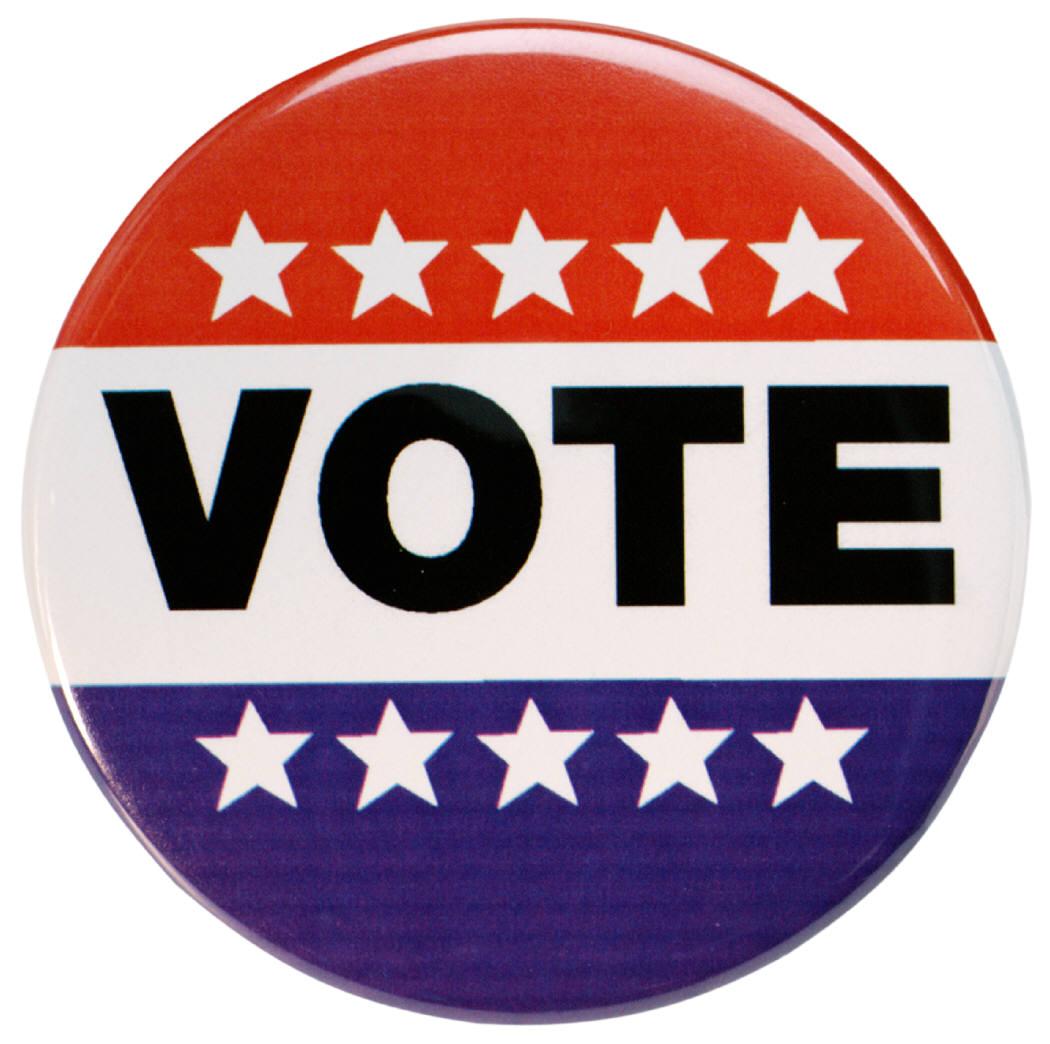Including ... Continuing Legal Education Update • Trainer Dave Spaulding on Maintaining Pistol Skills • Learning from the Zimmerman Case • President's Message • Vice President's Message • Attorney Question of the Month • Book Review • Networking Column • Editorial • About this Journal
get eJournal PDF: click here
Legal Education Seminar Attendance Urged
Your best weapon against unmeritorous prosecution or lawsuit following use of force in self defense is your own education coupled with being able to bring in your instructors as expert witnesses in your defense. By completing training similar to that which prosecutors, attorneys and judges pursue, you–the armed citizen now trained to the highest standard–are able to show a jury that you have met or exceeded your responsibility to society, having fulfilled your duty to fully grasp when use of force in self defense is allowable.
Though legislative breakthroughs have given armed Americans laws accommodating concealed weapon carry and while other laws clarify circumstances under which the citizen may use force up to and including deadly force to prevent a crime of violence against them, the scrutiny to which self-defense actions are subjected is not diminished. It is surviving the legal aftermath of self defense to which Network members have turned their attention.
Now Network members have an unusual opportunity to increase their training level to that of prosecutors, defense attorneys and judges because they can now study side by side with these legal professionals through our continuing legal education classes.
The Network will teach two continuing legal education seminars in 2012. The first is coming up quickly on June 19 and 20, 2012 in Eden Prairie, a suburb of Minneapolis, MN; the other is July 24 and 25, 2012 near the Sea-Tac International Airport, Seattle, WA. The meeting rooms are sufficiently large that we have plenty of room in both programs for not only the target audience of defense attorneys, but for other interested students, as well.
In these seminars, education in how to present an affirmative defense to the use of force in self defense blends with factual information about firearms and their defensive applications. To encourage Network members to obtain this documented training, we offer a 10% discount off the $400 tuition price for the two-day seminar.
Introducing the Faculty
Seminar faculty consists of defense attorney James Fleming who is Director of Legal Curriculum Development for the CLE program, Network President Marty Hayes, and Network advisory board member and internationally-recognized instructor and author Massad Ayoob.
Fleming has been a practicing attorney for 28 years and is a Felony Trial Specialist for the Minnesota State Public Defender’s Office. Before becoming an attorney, Fleming was a police officer and has served as an investigator for the Nebraska State Crime Commission. He was also selected as a finalist by the Minnesota Judicial Selection Commission for appointment to the Minnesota District Court Bench in 2008.
Ayoob’s credentials are too extensive to list in one paragraph, but he is probably best known as a prolific author, an instructor of nearly 40-years experience, court-recognized expert witness who has participated in high-profile defenses for defendants including Luis Alvarez, and many, many others. Ayoob is a former Vice Chairman of the Forensic Evidence Committee of the National Association of Criminal Defense Lawyers (NACDL), and is believed to be the only non-attorney to ever hold this position.
In addition to his role as founder and president of the Armed Citizens’ Legal Defense Network, Inc., Marty Hayes also brings over 20 years experience as firearms instructor and owner of The Firearms Academy of Seattle, Inc. Over the years he has served as an expert witness in a variety of cases involving firearms. His most prominent case was profiled on 48-Hours Mystery earlier this year.
In the course of their experiences, each instructor has time and again encountered utter ignorance about firearms, and an alarming lack of understanding about justifiable self-defense use of firearms among the defense bar, the judiciary and the jury pool. Only through education can the Network begin to cure this deficit, and our CLE faculty has worked hard to develop a two-day seminar to that end.
We encourage your participation in these seminars. Further details and registration information is at www.armedcitizensnetwork.org/legal-education/continuing-education.
[End of article.
Please enjoy the next article.]
Maintaining Pistol Skills:
Learning from Dave Spaulding
by Gila Hayes
Serious students of self defense must ask now and again, are my skills up to par? We attend training programs, yet weeks or months later, the skills gained seem to have slipped away. How to maintain and enhance shooting skill is of particular interest to Dave Spaulding, retired law enforcement officer, firearms instructor and popular author. 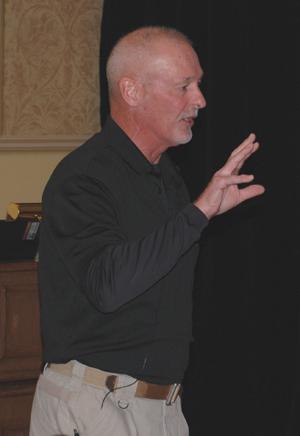 In January, I watched Spaulding engage an audience of some 200 in a two-hour evening program, in which he addressed these and other concerns. Impressed, I asked him for an interview to further explore his conclusions and he graciously agreed.
In January, I watched Spaulding engage an audience of some 200 in a two-hour evening program, in which he addressed these and other concerns. Impressed, I asked him for an interview to further explore his conclusions and he graciously agreed.
Spaulding made law enforcement his career, putting in 28 years working duties ranging from SWAT, undercover, homicide, communications, jail and patrol. He retired as lieutenant several years ago. In his book Handgun Combatives, he relates that he matriculated through police academy in the days when shooting qualifications were done at 7 to 60 yards, but also at the time when officers were expected to close on and physically control suspects. Training largely ignored the “close quarter combat situations…between three feet and 21 feet,” he writes.
Working in the close quarters range worried him then as it does now and on this concern he has focused much of his own study and development. Spaulding made it a point to ask World War II, Korean and Vietnam war veterans about their experiences, as well as sounding out police and armed citizens who had defended self, family, home and country. While working in corrections, he added to his knowledge base by talking to inmates, too.
Keeping Skills Sharp
Spaulding cites a well-accepted premise among sports trainers that physical skills are lost at a rate of as much as 20% a mere two to three days after training is over. To avoid that loss, professional shooters undertake what most would consider an extreme amount of practice.
Considering budget and time constraints, what possible hope is there for armed citizens who study defensive pistolcraft but are not law enforcement professionals or professional competitors, I asked him.  First, Spaulding corrects, the term “defensive” pistolcraft implies being behind the curve, back on your heels, not ready to act. “Defense means losing slowly,” he exclaims. Spaulding prefers the term “combative,” citing, as he does so often, the dictionary definition and putting special emphasis on the portion that speaks to willingness and readiness to act. That is the word picture this noted trainer and author attaches to self-defense skills with the handgun. “You don’t have to shoot like a grand master, you just have to be willing to stand there and fight,” he explains, adding, “That part is tough to train.” Top-dollar gear and training is of little use without willingness to take the necessary life-saving steps, he stresses.
First, Spaulding corrects, the term “defensive” pistolcraft implies being behind the curve, back on your heels, not ready to act. “Defense means losing slowly,” he exclaims. Spaulding prefers the term “combative,” citing, as he does so often, the dictionary definition and putting special emphasis on the portion that speaks to willingness and readiness to act. That is the word picture this noted trainer and author attaches to self-defense skills with the handgun. “You don’t have to shoot like a grand master, you just have to be willing to stand there and fight,” he explains, adding, “That part is tough to train.” Top-dollar gear and training is of little use without willingness to take the necessary life-saving steps, he stresses.
Decisive action as dictated by circumstances, be that beating a rapid retreat or standing and fighting, requires confidence: confidence in our preparation, our skills and our abilities. Spaulding points to the reputation of historic western lawman Bat Masterson, whom Wyatt Earp wrote was, “absolutely destitute of fear.”
[Continued...]
Confidence, Spaulding explains, is the leading factor in reducing fear, adding that self-assurance is the product of skill, and skill, of course, comes from dedicated training and practice. 
Skill maintenance and improvement has several facets, he continues. The first is keeping the fundamentals sharp and ready. “Your skills will never be good without the fundamentals,” he emphasizes. What are the fundamentals, or what Spaulding prefers to call “essentials”? Drawing the handgun, presenting it to target, trigger control and all of the skills needed to keep the gun running, he defines.
Among his numerous references to knowledge from times past, Spaulding cites NYPD notable Frank McGee and what he called the Rule of Three in early compilations of police-involved shooting data. Of shootings McGee quantified, on average the distances would be around three yards, and three rounds would be fired in about three seconds. In other words, gunfights were close-in affairs that started and ended very quickly, with only a few shots. This puts considerable value on getting the gun from the holster and up on target efficiently and accurately!
With practice, the presentation roughly aligns the pistol on target without much adjustment based on what we would strictly call sight alignment. Spaulding estimates that quite a lot of close-in defensive shooting is indeed what one might call point shooting. Pistol sights are “great training aids,” he comments, since sights give reference points to confirm the alignment on target that a skilled presentation stroke achieves.
Just as I thought the topic had wandered away from skill development and maintenance, Spaulding explained that by understanding which skills are most important, we are able to identify and pay most attention to key practice areas even when time and ammo budgets are limited. Furthermore, drawing and presenting a gun, as well as first-shot trigger control, are all excellent dryfire practice material, he adds.
Really, Spaulding continues, the only aspect of shooting to which live fire is truly necessary is managing recoil and multiple shot trigger control. Ten minutes of dryfire daily would go far to freshen and polish the fundamentals of drawing, presenting and applying controlled pressure to the trigger of the handgun, he stresses. The best training method to perfect a skill like drawing, presenting and firing a handgun, is performing the steps at half speed, and thus the trainee can perfect the motions required. The dryfire practice, he recommends, should incorporate the smooth and highly efficient motion from holster to on-target, performed perfectly at about half speed, working for what he calls “physiological efficiency.”
These days, anyone with a cell phone has access to another valuable skill-assessment tool, Spaulding continues. Video of fundamental skills reveals the shooter’s strong and weak points, he explains, noting that any modern cell phone has video capability.
Any training, and particularly range time, presents another, rarely acknowledged opportunity: practice in a single-minded and complete focus on the task at hand. “Concentration in training is the only path to concentration in combat,” Spaulding urges, commenting that students often seem distracted or not entirely focused on shooting drills during classes. Range time is an unequalled opportunity to prepare the mind to shut out the overwhelming distractions sure to arise if faced with the necessity to use a gun in defense!
Give high priority to practicing perfect grip, presentation, alignment on target, and consistent trigger press during training, Spaulding urges. These are the fundamentals, mastery of which he has been encouraging. He adds that another necessary skill is preparation for interaction with the assailant, commonly accomplished through force on force training.
[Continued...]
While participants in role-play or scenario-based training can’t entirely suspend disbelief to the extent that they believe life is at risk, the successful completion of simulated defense scenarios directly feeds the student’s confidence, he explains.
Spaulding urges that training and practice are the tools used to accomplish this goal: prevailing in a violent confrontation. “It’s a tall order,” he acknowledges, yet with focus on the fundamentals, concentration on the task at hand, consistency, accuracy and speed, that goal is in reach.
Getting the Word Out
Though he is now retired from policing, Spaulding is teaching and sharing his inspiration to improve combatives skill even more. In 2000 he co-authored Defensive Living: Attitudes, Tactics & Proper Handgun Use to Secure Your Personal Well-Being (second edition released in 2005) with Ed Lovette, and a few years later, he authored the first edition of Handgun Combatives (the second edition of which is reviewed later in this journal) for publication by Looseleaf Law Publications (http://www.looseleaflaw.com).
Expressing his dissatisfaction with the first edition, Spaulding relates how pleased he has been to rework the topics in Handgun Combatives’ second edition. In addition, he continues to write a regular column in Handguns Magazine (http://www.handgunsmag.com/), as well as contributing to several law enforcement publications.
Spaulding’s website http://www.handguncombatives.com/ as well as his training company’s Facebook pages at https://www.facebook.com/handguncombatives are sources of information about his training courses and his articles and books. There is even a blog to which he posts periodically.
[End of this article.
Please enjoy the next article.]
Learning from the Zimmerman Case
by Marty Hayes
A lot has happened during the month of May regarding the George Zimmerman case, and we’ll study some of it as part of our plan to keep our readers up to date each month until the case is effectively over. I said “effectively” because I do not believe this case will actually be over in the foreseeable future.
The biggest news is the evidence dump that occurred on May 17. In Florida, State law requires evidence in a prosecution to be disclosed to the public before trial. Because of it, we have a lot of evidence to analyze. First is the medical evidence pertaining to Zimmerman. Remember that Zimmerman was not charged after the incident and was released from police custody after about five hours. According to news accounts, the following day Zimmerman visited his family doctor (whose name has not been released, to my knowledge). Evidence from a medical evaluation by this doctor showed that Zimmerman suffered a broken nose, had two black eyes, two lacerations to the back of his head, a bruised lip and a minor back injury. This corroborates Zimmerman’s claim that Martin attacked him and his injuries were likely a factor in the decision not to arrest Zimmerman the night of the incident. It is also an example of why an armed citizen needs to document any injuries they have after a self-defense incident. The claim that the attacker assaulted you is typically documented in two ways. One is through eyewitness testimony; the other is by medical reports. The self-defense claim suffers when either of these is absent.
We should also note that the news media seemingly suggests that because Zimmerman was not hospitalized because of his injuries, they were not serious enough to justify deadly force in self-defense. What the media fails to mention or even understand is that the actual injuries are not the issue. Zimmerman’s perception of the severity of the attack he was suffering when he pulled the trigger is the issue.
The situation does not actually have to be life threatening to warrant the use of deadly force in self-defense. The person attacked just has to reasonably think it is life threatening. 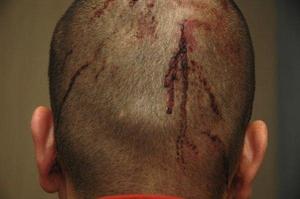
The jury will decide any questions on the “reasonableness” factor. It is up to Zimmerman to convince the jury that he reasonably believed his life was in danger. Is being struck in the nose with sufficient force to break it, and then being hit in the head with your head in contact with a concrete sidewalk constitute sufficient force to make you reasonably believe you are at serious risk? That is the ultimate question for the jury.
Last month, I wrote that I wanted to study the forensic evidence from this case. It’s like they read my article, because the autopsy report has now been released. From this report we come to understand what was actually occurring when Martin was shot. The report explains that the gunshot was to Martin’s left chest, the bullet track was front to back and the bullet pierced Martin’s heart. Assuming Zimmerman is right handed and that Martin was indeed on top of Zimmerman when shot, I speculate it corroborates Zimmerman’s account.
There is more evidence adding to the validity of Zimmerman’s story. There was soot and stippling on Martin’s body at the wound’s entry point. This indicates a close gunshot. Some reports say 2 to 4 inches; some estimates extend the distance out to 16 inches.
[Continued ...]
I want to know if any blood or skin was found and if samples were taken off the concrete. Were they matched to Zimmerman? If not, did the crime scene detectives screw it up? Remember in Network membership DVD#2 Handling the Immediate Aftermath of a Self-Defense Incident where we instruct members to make sure the police know of any evidence that is perishable or likely to disappear? This is a prime example. I understand that Zimmerman actually did a walk-through of the scene with the police shortly after the incident. I hope this was discussed and trace evidence collected. If not, it may not be too late for the defense team to collect this evidence. It might even make sense to take the part of the sidewalk Zimmerman’s head struck into court. (Just a suggestion). 
Exactly what was Zimmerman doing after hanging up with the 911 call center dispatcher? This is another issue that does not seem clearly resolved. Some have said he was returning to his car, others said that he was at his car. The scene of the death clearly shows he was between two town home buildings on a walkway. Was he returning to his car or not? And where was his car?
Next, I wonder why no photos were released of Trayvon Martin in situ. Why not? Let’s have full disclosure, prosecutors. I want to know if there were grass stains on Martin’s knees. It looks like there is more and more evidence to validate Zimmerman’s account of the incident, but even so, I want to know all the evidence, not just that which either backs up or disputes Zimmerman’s account of the incident.
[Continued...]
On to legal concerns: from what I have seen so far, it looks like the State of Florida is going to be putting all its eggs in one basket, as the evidence we have seen so far shows an act of self defense. If that’s so, I think the State will attempt to portray Zimmerman as the initial aggressor of the incident. If the State can convince the jury that Zimmerman wrongfully started the altercation, then his right to have acted in self defense will be stripped away from him by the court, and the jury will not be given a self-defense instruction. This will leave the jury with little choice but to convict Zimmerman of at least manslaughter. Let’s look at the Florida statute, which I was able to do thanks to Mitch Vilos’ great resource, Self Defense Laws of All 50 States.
F.S.A. Section 776.012 Use of Force in Defense of Person.
A person is justified in using force, except deadly force, against another when and to the extent that the person reasonably believes that such conduct is necessary to defend himself or herself against the other’s imminent use of unlawful force.
However, a person is justified in the use of deadly force and does not have a duty to retreat if:
(1) He or she reasonably believes that such force is necessary to prevent imminent death or great bodily harm to himself or herself or another or to prevent the imminent commission of a forcible felony.
The above is the general self-defense law of Florida. But, if one starts the fight, they cannot claim protection under the law of self defense, as follows:
F.S.A. Section 776.041 Use of Force by Aggressor.
The justification described in the preceding sections of this chapter is not available to a person who:
(1) Is attempting to commit, committing or escaping after the commission of, a forcible felony; or
(2) Initially provokes the use of force against himself or herself, unless:
(a) Such force is so great that the person reasonably believes that he or she is in imminent danger of death or great bodily harm and that he or she has exhausted every reasonable means to escape such danger other than the use of force which is likely to cause death or great bodily harm to the assailant; or
(b) In good faith, the person withdraws from physical contact with the assailant and indicates clearly to the assailant that he or she desires to withdraw and terminate the use of force, but the assailant continues or resumes the use of force.
As I read and apply the above statute, the known evidence of the Zimmerman case does not show George Zimmerman to have been the person to initially provoke use of force. While there is argument that Zimmerman should not have left his vehicle to keep an eye on Martin, no one is saying that what he did was illegal. Zimmerman was not in the process of committing a forcible felony on Martin, and there is no evidence that Zimmerman was the first to throw a punch. As I see it, there is no credibility to the State’s argument that Zimmerman was the initial aggressor in the altercation. Still, we have not seen all the evidence, but instead are only analyzing what we have to date.
As of the writing of this article, we know little more about the case, and just today, Zimmerman’s attorney Mark O’Mara asked that Zimmerman’s statements to police be sealed, along with witness statements. The reason is that many of these statements may not be admissible in a court of law, and it is my understanding that O’Mara doesn’t what this information to taint the jury pool. That seems reasonable to me. For additional commentary, see the President’s Message, on the following page.
[End of article.
Please enjoy the next article.]
President’s Message
 by Marty Hayes
by Marty Hayes
This month, I am going to wade knee-deep into the racial/political issues surrounding the Trayvon Martin/George Zimmerman case. It was my original intent to avoid discussing these intangibles, but the recent revelation that some single digit IQ imbecile made up a run of “Trayvon Martin Hoodie targets” to be used at gun ranges and that people actually bought these targets has just set me off. We honest, law-abiding gun owners have enough to worry about from the mainstream media and anti-gun politicians, without bringing this type of scrutiny down upon gun owners. It is no wonder many people view gun owners as knuckle-dragging, wife beating, one syllable word-using Neanderthals. If this is the first time you have heard about this stinky little episode, just do a Google search for “Trayvon Martin Hoodie Target.” 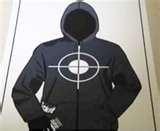
But even this outrage pales in comparison to the advertisement I saw in the April 13th, 2012 edition of the St. Louis Post-Dispatch. The full-page advertisement states, “The last thing America needs is gun-toting vigilantism that makes all of us less safe,” accompanied by the picture of a cute, young Trayvon Martin. This advertisement goes on to make inflammatory statements like, “The gunning down of Trayvon Martin” and “Trayvon’s murder is heart wrenching,” and more. This advertisement coincided with the opening day of the 2012 N.R.A. annual meeting, and was placed in the paper by an organization called LicensedtoKill.Org. Look them up on the Internet; their website is quite illuminating. Of course, there was also Jesse Jackson, Al Sharpton and some pink-hatted lady congresswoman ranting and raving about how Zimmerman murdered Martin, how Martin was “hunted down like a rabid dog” and executed.
So, where does all this hate-speak leave you or me, the average gun owner, who just wants to live a life free of worry of prosecution for legitimate acts of self defense? While I can’t speak for our members, I can speak for myself, and what I have seen from our anti-gun press and politicians makes me fearful.
 Consequently, it is incumbent upon each and every one of us to not give any ammunition to those who might want to run us through the same gauntlet that Zimmerman has been through. We must strive to rise above the fray that has become so commonplace in the world of the gun, and choose to fight battles that are truly worthwhile. We must back those politicians who have honorably supported our right to keep and bear arms, and work to defeat those who would see our right to peaceably provide for the protection of ourselves and our family taken from us.
Consequently, it is incumbent upon each and every one of us to not give any ammunition to those who might want to run us through the same gauntlet that Zimmerman has been through. We must strive to rise above the fray that has become so commonplace in the world of the gun, and choose to fight battles that are truly worthwhile. We must back those politicians who have honorably supported our right to keep and bear arms, and work to defeat those who would see our right to peaceably provide for the protection of ourselves and our family taken from us.
At this moment, as you are reading this, federal prosecutors and FBI agents are looking through every text message and Facebook post Zimmerman has ever made, to see if they can make a hate-crime case against George Zimmerman.
Remember the Rodney King incident? The four Los Angeles cops that went on trial and were acquitted of wrong doing for their use of force against King were next prosecuted in federal court for violating King’s civil rights. They lost that case. Those cops were subjected to this kind of scrutiny. There is no doubt that federal agents are contacting Zimmerman’s past employers, past and current friends and even his ex-wife, in an attempt to piece together a portrait of George Zimmerman, the racist. They are looking for the smoking email that can be used against him in Federal Court, in the event Zimmerman is either acquitted or the charges are dismissed.
I ask you, could you pass such scrutiny? I hope so.
[End of article.
Please enjoy the next article.]
Vice President’s Message
 by J. Vincent Shuck
by J. Vincent Shuck
Watch any TV news program or read any daily newspaper, to the extent anybody does that today, and you will probably hear or read about the upcoming Presidential election. It’s an important issue.
While not the only November election topic, but the one that draws the most coverage and debate, the Presidential election is critical to those of us who want to protect our constitutional freedoms. Please don’t bypass this opportunity to influence who occupies the White House for the next four years and who represents you in local, state and national elected positions.
What’s the big deal, you might wonder? Well, not everyone may agree with our viewpoint and I’ve even stood on the firing line in classes and participated in shooting events with individuals who have said, “I’m not into politics” or “How can my vote count?” This is my chance to address those lackadaisical attitudes and offer some ideas. 
Some pundits are now saying that Romney is currently leading Obama in some polls and will win going away. I’m not sure about that and know the five months until the election is a virtual lifetime in politics; a lot can happen. However, before we get too far into the political weeds, let’s make sure we are in agreement that a Romney win is best. Maybe he wasn’t your first choice during the primaries, but grant me a chance to outline why, even on his worst day, Governor Romney, who just clinched the nomination, represents a better choice for us than President Obama.
Obama’s belief in the Second Amendment is far different than mine. He has expressed his opinions by voting against pro-gun legislation while serving as a state legislator in Illinois, wants to reenact the “assault” weapons ban, opposes concealed carry, surrounded himself with like-minded staff, including now Chicago Mayor Emanuel and Attorney General Eric Holder, and has feigned support for the Second Amendment but pointed out that there is no individual right to keep and bear arms. More details on Obama’s anti-gun antics are available at www.gunbanobama.com. 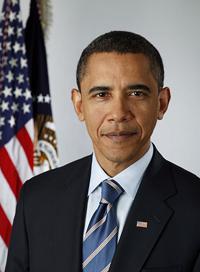
I offer one last thought about the dangers of an Obama re-election. Consider the Supreme Court. His two first term appointments of Justices Sotomayor and Kagan, one who sided with the minority in McDonald and the other whose history brings an anti-individual freedom mentality, foretell how he would make additional appointments in his second term. Admittedly, those Justices who chronologically might retire during an Obama second term are mostly liberal-leaning, but what might happen if one of the current more conservative Justices decided to retire, had a health problem or got hit by a bus? The Court’s actions would change for the remainder of our lifetime because its makeup would be able to overturn the recent pro-gun successes.
Finally, another term would place Obama in the position of not being eligible for another election, thus, he could, without any re-election intimidation, mandate various executive orders, initiate litigation and approve regulations that would create unending challenges to our firearm rights.
Sure, his efforts could be overturned eventually, assuming we have an understanding Supreme Court, but in the intervening decade, we could be faced with higher taxes on ammunition, bans on certain firearms and UN treaties that prohibit firearm importation.
I believe the Presidential race will be a close election; therefore, we will need every vote we can get. Let’s start with you first. Are you registered to vote? Or, just moved and need to register in your new location? Get it done. Check the Internet for your state’s voter registration process or go to www.triggerthevote.org, the NRA-related web site that will take you to your state’s voter registration process. If you know any Second Amendment supporters who aren’t registered, offer guidance and encouragement so they are ready to cast a ballot with us in November.
With voter registration behind you, you have a few other ways to help defeat Obama and his other Congressional supporters. Political campaigns at all levels depend upon contributions. Please consider a donation to support Governor Romney. Go to his web site at www.mittromney.com or to the NRA’s site at www.nraila.org.
If you want to donate directly to a local candidate, do so on that candidate’s web site or attend one of their fundraising events.
To sum up, get registered, get involved and get Obama packing - out of the White House.
[End of article.
Please enjoy the next article.]
Network Affiliated Attorney Question of the Month
 With the generous help of our Network Affiliated Attorneys, this column helps our members understand the world our affiliated attorneys work in, and demystifies various aspects of the legal system for our readers.
With the generous help of our Network Affiliated Attorneys, this column helps our members understand the world our affiliated attorneys work in, and demystifies various aspects of the legal system for our readers.
This month, we asked our affiliated attorneys:
“During the investigation phase following an incident of a homeowner shooting a burglar, it is common for police to ask to take custody of ALL the firearms in the residence. Is this common in your jurisdiction, and what do you recommend your clients do or say when confronted with this request? For the purposes of this question, assume all guns other than the one the client used in self defense are locked in a gun safe.”
We got so many great answers that this question will be continued on into the July edition of the journal.
Warren Stephens
DeCaro Doran Siciliano Gallagher & DeBlasis, LLP
17251 Melford Blvd., Ste. 200, Bowie, MD 20715
301-352-4950
www.decarodoran.com
I have not heard of a situation where the police wanted to take custody of all the guns, including those locked in a gun safe. However, if my client were confronted with this situation, I would recommend that he/she not give the police the guns or access to the guns.
Private ownership of a firearm is an inherent right and is constitutionally protected. The firearms in the gun safe are irrelevant to the investigation of a self-defense shooting. If the police had reason to believe that the firearm apparently used by the homeowner was not the firearm actually used, or that there is some public or police safety issue by having firearms in a gun safe, then I would recommend that the police get a warrant. It is unlikely that a judge would find probable cause for taking custody of guns locked away in a safe.
Franklin B. Joyner, Jr.
170 Second Street , PO Box 1434, Cheraw SC 29520
843-253-5316
http://chesterfieldcountytrafficlawyer.com/
It depends on which agency is investigating the incident. A municipal police department may differ from a sheriff's department or State Law Enforcement Division. Typically, the investigating agency will only keep as evidence the firearm used during the act of self defense, especially considering all other firearms are safely locked away.
I recommend to all my clients this: WHEN IN DOUBT, DO NOT SPEAK TO THE POLICE, EXCEPT TO DEMAND AN ATTORNEY. With that being said, if the investigating agency asks for permission to take possession of all firearms on the premises, either calmly and respectfully deny this request or simply say nothing at all.
Kevin E. J. Regan
The Regan Law Firm, L.L.C.
1821 Wyandotte St., Ste. 200, Kansas City, MO 64108
816-221-5357
www.reganlawfirm.com
I practice law primarily in the states of Kansas and Missouri. I am a former state and federal prosecutor and have been in private practice doing criminal work at the state and federal level in both states for over twenty-five years.
I have checked with law enforcement officers in both jurisdictions and do not believe that it is common in these two states for police to attempt to take custody of all unrelated firearms in the residence where a homeowner shot an intruder in self defense. On some occasions, this may occur, however, such as in cases of alleged domestic violence.
My advice to armed citizens who find themselves in this situation would be rather simple.
I quite agree with Marty Hayes, Massad Ayoob and other contributors to your newsletter that a brief statement should be made to the initial police responder to the effect that you have been victimized by an intruder, burglar, rapist, assailant, etc., and that you had to use your firearm to defend yourself against the immediate threat of serious physical injury or death.
Beyond those brief initial statements, I believe the homeowner should invoke his/her right to remain silent, as well as their right to counsel guaranteed by the Fifth Amendment to the United States Constitution, as well as the constitution of their individual state of residence.
I would not recommend that the homeowner volunteer that there are other unrelated firearms in the home locked up in a safe or a gun vault.
If the officers ask for a consent to search unrelated portions of the home, I would advise my clients to respectfully decline.
If the officers requested specifically to search a gun safe that they had found in the house, or asked for the keys or combination, I would advise my clients to respectfully refuse the officers’ request and ask them to get a search warrant.
Ordinarily, a warrantless search of a citizen’s home is illegal, pursuant to the citizen’s rights guaranteed by the Fourth Amendment to the United States Constitution. This amendment guarantees the right of the people to be secure in their persons and houses against unreasonable searches and seizures.
There are, however, several well-known exceptions to this warrant requirement for a search of one’s home. Exceptions to this rule are searches incident to arrest, exigent circumstances, plain view, defense of officer, and several others.
Once a citizen has surrendered his/her weapon that was used in the encounter that brought the police to the home in the first place, the officers may no longer be in any danger. All arguments for exigent circumstances may be gone. A search incident to arrest may not authorize officers to go to another part of the home and search a safe containing unrelated firearms.
By following this strategy, the officers would be forced to get a search warrant. If the judge would issue a search warrant, it could be subject to attack later with a Motion to Suppress fruits of the search.
There is certainly no legal requirement for a citizen to voluntarily turn over the entire contents of a safe containing unrelated firearms in a case such as this. Should a suspect’s associates return to seek vengeance against the homeowner, the homeowner would be defenseless to counter use of deadly force.
As a practical matter, should the homeowner be charged, as a special condition of bond, he/she may be ordered not to possess firearms throughout the pendency of the case. In this situation, I would advise the client to find a responsible relative to keep the firearms securely until the case is resolved in my client’s favor or that specific bond condition is lifted.
Good luck and safe shooting.
Mitch Vilos
Attorney at Law
P.O. Box 1148, Centerville, UT 84014
801-560-7117
http://www.firearmslaw.com/index-attorney.html
In my humble opinion this is probably a civil rights violation. I have dealt with this issue with a fairly high-profile shooting here in Salt Lake City where the homeowner shot and killed the unarmed intruder through a glass door at 3 a.m. He contacted me by email. I immediately called the District Attorney and found out that they did not plan on filing charges against the homeowner. I explained how this left the homeowner disarmed and helpless. Fortunately, here in Utah, most police and prosecutors give some deference to the right to keep and bear arms. We were able to recover the firearms, including the one used in self defense, quite quickly.
Generally, lawyers speaking to lawyers can get things done quicker than a citizen speaking to the police or prosecutors (which could raise a host of other problems beyond the scope of this question). So contact your lawyer immediately and put him to work getting your guns back for you.
[Continued...]
Here’s an interesting aside: There was an accomplice to the burglar who turned himself in. I thought the police might need the weapon as evidence in a felony-murder case against the accomplice. In most states, if you are committing a serious felony and your accomplice is killed, you can be convicted of murder even though he was shot by someone else, like a citizen or police officer. The accomplice was a young man who apparently had never been involved in anything like this before and was devastated his friend had been killed. Police and prosecutors declined to prosecute for felony-murder, so they returned my client’s self-defense gun.
L. Erickson Walker
Attorney at Law
121 SW Morrison St., Ste. 1575, Portland, OR 97204
503-224-5468
http://www.gordonrees.com
I thought given my prosecuting attorney background, that this was a very interesting question, and one that I would like to follow up on. I spoke with a few Deputy DAs and some detectives down here in Multnomah County, Oregon about the question.
The consensus was that the police will question a homeowner about whether they have any other firearms in the house and/or premises. If there are additional firearms, they will ask to take into custody all of them. The firearm which was used in the altercation is of course likely not to be returned until the criminal investigation is complete. However, they will not hold that firearm forever, and would not hold it for a civil suit that might come later.
As for the other firearms, they will take those, fill out an evidence tag, and just do quick ballistic tests to make sure they were not used in the altercation, or any other altercation to follow up on unrelated criminal activities. My subjective understanding however is that if there is some inclination that the homeowner was not totally upfront or honest about the altercation, or that there is fairly clear evidence that the homeowner might not have been justified in the shooting, these additional firearms will not soon be returned. All other things being equal however, those additional firearms will be returned in a matter of days, according to these Multnomah County folks I spoke with.
One additional point, of the five Deputy DAs and Detectives I spoke to, all agreed that the homeowner could decline to turn over those locked up additional firearms. However, the police would seek a warrant, which would undoubtedly be granted, to enter the home and take those firearms. At that point, they all admitted much of the trust they might normally have in the homeowner would be lost, making the subsequent investigation much more complicated and difficult.
______
This topic will continue next month with more answers to this question from our affiliated attorneys. We appreciate their contributions! Members can log in to http://www.armedcitizensnetwork.org/affiliates/attorneys to view attorney lists for the various states.
[End of Article.
Please enjoy the next article.]
Book Review:

Handgun Combatives
2nd Edition
Dave Spaulding
Foreword by Kelly McCann
ISBN 978-1-60885-024-2
Looseleaf Law Publications, Inc.
220 pages, softcover, illustrated
$23.95
www.looseleaflaw.com
Reviewed by Gila Hayes
I met Dave Spaulding over twenty years ago, and renewed acquaintances with him from time to time at gun press events. His magazine articles were always a welcome blast of reality and I would often turn first to Spaulding’s articles in magazines. That’s why I’m not sure how I missed the first edition of his book Handgun Combatives, but after renewing acquaintances with Dave, I was eager to delve into the second edition of his book about handguns for defense and duty.
Handgun Combatives starts with a chapter on mindset, since, as the book’s introduction puts it, “one must begin by making themselves combative or all else is a waste of time and effort.” Spaulding prefers the term “combative mindset” to words suggesting survival, which he believes is a poor alternative to prevailing in a fight. While discussing the problems inherent in defanging an attacker who is already fully in fighting mode, the author draws on diverse sources ranging from Jeff Cooper to Col. John Boyd.
Spaulding stresses that simple technique is essential, as is mental readiness to act. Training methods to develop combative skills include visualization and mental training that invokes the emotions and some of the physiological effects of a violent encounter. He interviews Marcus Wynne, who believes that combatives training often falls short of its potential because students learn the skills while in a training mindset. If required to execute the skills in a crisis, a substantial time lag before reaching the combative mind state occurs, he posits.
In the third chapter, Spaulding addresses a topic near and dear to the Network and its members – the legal repercussions following use of force in self defense. Fear of being sued may delay decisive action in an emergency, he worries. Spaulding’s aftermath advice is on-target, a refreshing surprise on a topic so fraught with misinformation!
Physical fitness, non-gun defenses, self-help first aid, and support equipment including lights and knives are recommended in the pages to follow. In discussing handgun selection, Spaulding notes that he is not by nature a gun collector, though he has a utilitarian selection of firearms for various functions. This book focuses on the semi-auto and he does not tackle parallel instruction for revolvers, for which he recommends Ed Lovette’s book, The Snubby Revolver. He goes on to make good observations about handgun fit and customization.
Without delving far into specifics, Spaulding introduces selecting defensive ammunition, then moves quickly to fundamental shooting skills. He reiterates the necessity of techniques stripped down to maximum simplicity, noting that while no armed confrontation is ever simple, under stress, humans certainly do become “simple.” From this he introduces the importance of continuity, or what he dubs the continuous motion principle.
The next chapter moves into grip, body position, trigger finger independence and more. Agreement with specific technique recommendations is not so significant as grasping the principles that Spaulding emphasizes. A discussion of various ready positions leads to an explanation of pistol sight use and point shooting, which Spaulding insists, all shooters do to some degree. Next, he explains why classic shooting stances are impractical, since foot and lower body position changes when the shooter moves. Instead, the individual needs to find a firing platform that is natural to their normal stride and how their body moves, though Spaulding also recommends practice from a variety of disadvantaged positions. “You will realize that shooting is really done from the waist up and that placement of the feet is not important,” he writes. Body weight needs to be somewhat forward, he adds, explaining that recoil control “is easily accomplished by leaning the upper torso and shoulders into the gun.”
It may seem that Spaulding digresses back to equipment when he introduces holster selection, but after offering recommendations, this trainer is back to technique, explaining how to draw from a holster. “Holster skills are a critical part of handgun combatives,” he writes. “As a matter of fact, they are probably just as important as being a good shot.” He teaches simplicity and consistency, emphasizing the need for practice.
Loading, unloading and clearing malfunctions come next, and though Spaulding asserts that the semi-automatic pistols of today are extremely reliable, man-made tools fall short of perfection, so the operator needs skills to keep the gun running. Besides, malfunctions stem from a variety of causes, including operator error, bad ammunition and worn magazines, so proficiency in the skills discussed is critical if carrying a semi-auto for defense. The author’s techniques differ from the mainstream, but he gives good rationale for them. The smart reader should explore if the Spaulding methods might speed the goal – getting the semi-auto operational after a malfunction.
Likewise, Spaulding’s view of how to move while shooting may differ from skills taught by others, but bear this in mind: he is entirely correct when he emphasizes that in real-life assaults aggressors do not stand still nor should the defender! He also outlines concerns about falling and shot placement that justify his preferred techniques. This important chapter also discusses use of cover and non-dominant hand shooting.
The next chapter examines multiple threats, and Spaulding observes, “Criminals tend to draw courage from one another and do things a lone person will not do. So it only makes sense that they are more likely to attack another person when they have someone with them.” Practice and training on targets lined up in a row is unrealistic, he explains, discussing instead tactics like stacking assailants so one protects you from the other, allowing you to engage the closest first, and thus reduce the immediate risk. Movement, an aggressive counter attack and willingness to fight, may get inside the aggressor’s reactive time, Spaulding explains.
A valuable chapter on low light follows and Spaulding gives a good briefing on the common methods of deploying white light during searches, with or without guns drawn. Owing to the amount of time many spend in automobiles, he also offers a chapter on shooting from the confines of a car and how to use it as cover. He also recommends high performance driving training, a sensible suggestion, since usually the best solution is to use the car to escape. The automobile chapter closes with an interview with Ed Lovette, a driving expert who points out, “People only feel that they are armed and able to take care of themselves if they have a handgun and it’s only because they don’t know what they can actually do with a car.” That’s just one gem of information; the rest also comes highly recommended, including advice about what to do if driving away is untenable. If you recognize the gold mine of common sense in that interview, go to Looseleaf Law (www.looseleaflaw.com) and also buy the book Lovette and Spaulding co-authored entitled Defensive Living.
The same practical approach characterizes Spaulding's chapter on close quarters fighting, a grittily descriptive argument on contact-distance defenses emphasizing the necessity of empty-hand skills. This is Spaulding at his persuasive best, blending law enforcement experience with knowledge gleaned from others.
Handgun Combatives ends with a chapter on skill maintenance and development. Spaulding reminds the reader that perfect practice, not necessarily done lightening-fast, is the key to proper technique development. He adds suggestions about how to perform perfect practice that touches on mental aspects, using video, as well as the role of kinesiology in performing physical skills.
Handgun Combatives is a great review and inspiration to experienced shooters, and a good intermediate-level lesson book for those who are newer to the subject. Get it and learn!
[End of article.
Please enjoy the next article.]

Networking
by Brady Wright
Moving into and past the Memorial Day weekend, I resolve that, in this column, I will focus on things other than the Zimmerman/Martin case, even though many of you have discussed it in the emails and calls since the last issue. There have been more than enough great developments in other areas of our organization, so let’s take a look at some of those!
I had several exchanges with our friend Chaz Murray. Chaz does a great podcast called, The Road Gunner Podcast and he’s a strong promoter of the Network. You can find it, and many of his other posts at his website www.roadgunner.net.
Speaking of electronic things, our affiliate Gale Burton of Burton’s Firearm Instruction, Inc. in Mountlake Terrace, WA sent me a very cool video that is one of the best reasons I have seen NOT to use one of those common combination padlocks. The video lasts about four minutes and shows how nearly anyone can open one of those locks with no skill or special tools other than a pop can. If you do a Google search for combolock-1.wmv, it will come up. You can reach Gale to learn more about her excellent classes at
Affiliate Rick Walker of Olympia, WA is an active NRA instructor and owner of Black Dawg Training, where he specializes in pistol training, Personal Protection in the Home, Home Firearm Safety, Refuse to be a Victim classes and other offerings. He is also an NRA Certified Chief Range Safety Officer, a Utah Certified Concealed Carry Permit Instructor and graduate of Firearms Academy of Seattle and Massad Ayoob’s classes. That’s a lot of experience under one hat! Rick’s contact info is:
Just a few days before the journal deadline I talked with Pat Sacco in New York. He said, “I am doing my best here in the people’s republic of NY to get full concealed carry permits for people. I am one of a very few instructors in NYS that judges will issue [permits] with the ‘critical need’ demonstrated and my training.” Pat has been doing this for about 20 years and has great credibility with the judges as well as with NYS Division of Criminal Justice Services. Pat says he is going to focus on promoting the Network and its agenda in all of his classes!
Another of our instructor affiliates is Alecs Dean. I’ve seen folks who have a big bite to chew, but Alecs may need a bigger plate! He supplies five different gun stores (including Shoot Straight, the largest gun dealer in Florida) and about two dozen firearm instructors with our booklets. He makes sure they are all stocked up and has set up a counter-top display with brochures and booklets in several of the gun stores. Several local sheriff departments also distribute our booklets and Alecs stocks them, as well. His company is International Firearm Safety, Inc., in Fort Myers, Florida. I think he may win the “Johnny Appleseed” nod for this month! Alecs, I’ll stand you to a few cups of coffee on me, next time we cross paths!
I heard from Wolfgang Rotbart the other day. He’d been to the Albany, Oregon Full Auto Shoot and set out Network pamphlets along with his business cards, and had quite a few takers. Wolfgang is also active on our Facebook page and his company is The Gun Doctor. His office number is 503-429-7342.
Thanks for the great response to our group emails, affiliates! We make good use of email to let everyone know what’s going on and there is more to come, as well as some really cool new developments. Make sure to set your emails filters to accept our ISP as one of the good guys. If you get an email from me, it’s not an ad and no salesman will call, I promise!
There's more to come next month from your Networking fool. Stay safe out there!
[End of article.
Please enjoy the next article.]
Editor’s Notebook

The Good Guys
Act Differently
by Gila Hayes
“Did I ever tell you about the time the police held me at gunpoint?” my friend Joe interjected into a perfectly normal telephone visit one afternoon. Knowing that this gentleman is a defensive firearms instructor and without any question a pillar of his community, I was, of course, surprised and intrigued.
The precipitating cause and the event itself were uneventful. My friend was taking a rifle from his home to a gunsmith only several blocks away. A passer-by caught a glimpse of the gun and called the Boise, ID police to report a man with a gun. “I guess I didn’t have it hidden well enough,” my friend commented. As he was being taken from his vehicle at gunpoint, Joe realized it was the perfect testing ground for the instruction he had long taught students about interacting with responding police officers, so he remained quiet and behaved cooperatively. When Joe was given the opportunity to explain why the rifle was in his vehicle, the situation was quickly resolved with no bad consequences.
For most of us, the story would have ended there, and probably provided fodder for complaining to our other armed friends about society’s fear of guns and possibly about law enforcement, too. That was not the path Joe took!
Instead, he went to the community police ombudsman and said he wanted to document the correct and professional behavior of the officers handing the call, and he was insistent that his compliments be placed in the officers’ permanent employment records.
“Some day, a similar incident will happen,” Joe explained, pointing out that not all armed citizens will recognize police professionalism, and some may even lodge a complaint where none is due. He intended to offset that kind of ignorance with his own positive report.
Why am I passing this story along?
When we discuss the aftermath of a shooting or other self-defense incident we emphasize that responding law enforcement officers have no way to know that you acted justifiably and may well treat you like a suspect or a criminal during their contact with you. We encourage a non-argumentative attitude and response while the details are being sorted out. While his circumstances were far less dire, Joe certainly exemplified that behavior. However, once the facts were all sorted out, he went far beyond behaving like the good guy, and gave us a wonderful example of a good citizen’s concern for the long-term well-being of his community and its peacekeepers by taking steps to assure that the good behavior and professionalism of law enforcement in his community was recognized and reinforced.
In pondering the conversation, I’ve realized that being a good citizen can go a lot further than protecting our freedoms, paying our taxes, and looking out for the little guy. Joe’s follow up was an investment in future good results when law enforcement comes in contact with a legally armed citizen behaving legitimately within his or her rights. Policing, like any profession, has good and poor members. It is to our long-term benefit if the good is encouraged, nurtured and given the chance to become the norm, not the exception.
[End of Article.]
About the Network’s Online Journal
The eJournal of the Armed Citizens’ Legal Defense Network, Inc. is published monthly on the Network’s website at http://www.armedcitizensnetwork.org. Content is copyrighted by the Armed Citizens’ Legal Defense Network, Inc.
Do not mistake information presented in this online publication for legal advice; it is not. The Network strives to assure that information published in this journal is both accurate and useful. Reader, it is your responsibility to consult your own attorney to receive professional assurance that this information and your interpretation or understanding of it is accurate, complete and appropriate with respect to your particular situation.
In addition, material presented in our opinion columns is entirely the opinion of the bylined author, and is intended to provoke thought and discussion among readers.
To submit letters and comments about content in the eJournal, please contact editor Gila Hayes by email sent to
The Armed Citizens’ Legal Defense Network, Inc. receives its direction from these corporate officers:
Marty Hayes, President
J. Vincent Shuck, Vice President
Gila Hayes, Operations Manager
We welcome your questions and comments about the Network.
Please write to us at 

